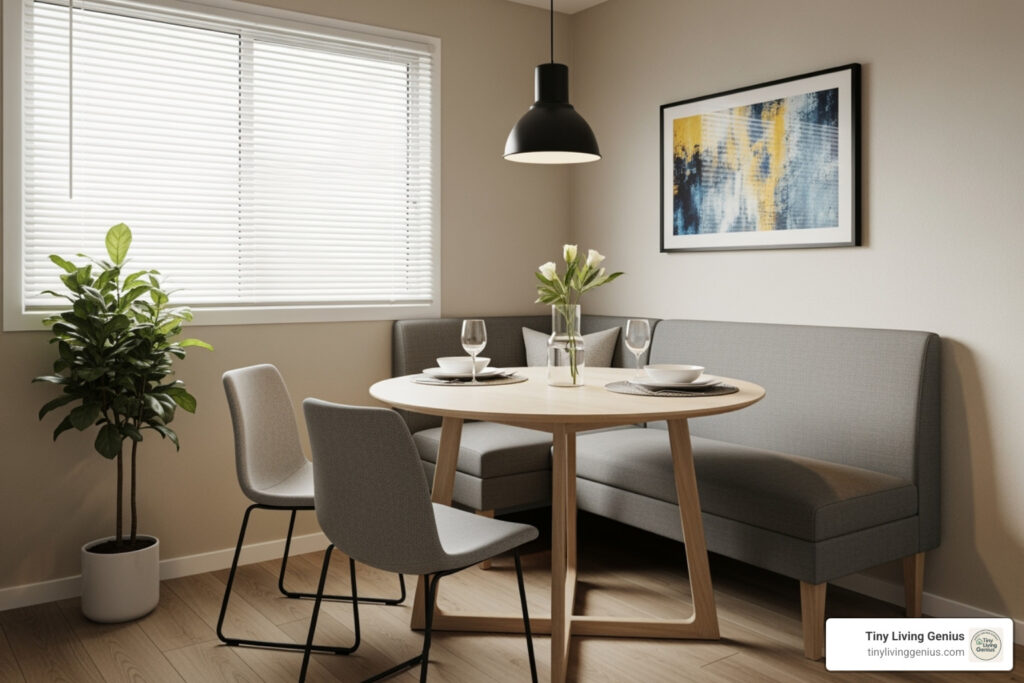Small table dining room: Perfect 4-Seater
Why Your Small Table Dining Room Deserves Better
A small table dining room doesn’t mean sacrificing style or function. The right dining table—whether a compact 4-seater, a space-saving round table, or an extendable design—can transform a tight space into a warm gathering spot. Furnishing a small dining area is a common challenge, but high demand has driven incredible innovation. Today’s small dining tables offer clever designs in various shapes and materials to maximize every inch.
Quick Guide to Small Dining Tables:
| Priority | Best Choice | Why It Works |
|---|---|---|
| Maximum flexibility | Extendable or drop-leaf table | Expands for guests, saves space daily |
| Tight square room | Round table | Easier navigation, no sharp corners |
| Narrow space | Rectangular table | Fits against walls, doubles as desk |
| More legroom | Pedestal base table | Single center leg frees up floor space |
| Extra storage | Table with built-in shelves | Reduces clutter, maximizes utility |
A dining table is more than furniture; it’s where life happens. It’s the spot for casual meals, homework, and gathering with friends. A well-chosen table creates a dedicated zone that makes any space feel more like home.
The key is matching features to your space. Round tables suit square rooms, while rectangular ones are great for narrow spaces and double as desks. Pedestal bases add legroom, light colors create an airy feel, and extendable designs offer flexibility for guests.
As the founder of Tiny Living Genius, I’ve spent years helping people solve small-space puzzles. Let me walk you through everything you need to know to find your perfect table.
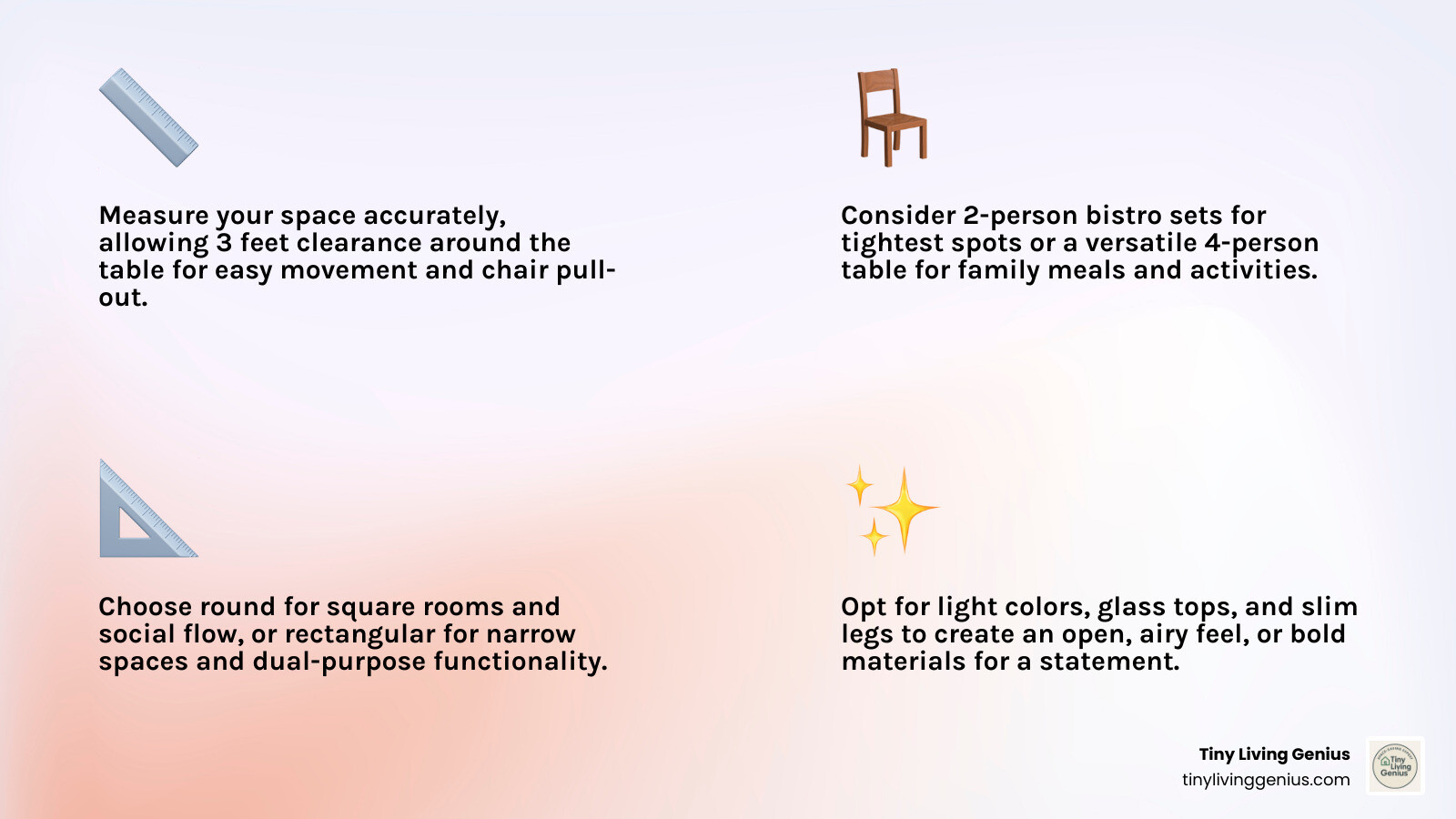
Important small table dining room terms:
- dining tables circular
- round dining table for 4
- small kitchen table island
The Everyday Hub: Benefits of a 4-Seater Dining Table
A 4-seater in a small table dining room is more than a place for dinner; it’s a central hub that earns its keep every day.
This table becomes the spot for Sunday morning pancakes, after-school homework, or daytime work on your laptop. In the evening, it clears off for a casual meal with friends.
The magic of the 4-seater is its perfect balance of size and function. It’s roomy enough for a small family or a few friends, with space for serving dishes, but it won’t overwhelm your floor plan.
Beyond meals, its versatility shines as a craft station, puzzle zone, or impromptu office. It provides a proper dining experience—not balancing plates on your lap—while defining a gathering spot and keeping your space feeling open and livable.
For anyone navigating compact living, understanding this everyday functionality is crucial. Choosing Furniture for Small Spaces Effectively means picking pieces that work this hard for you without demanding more space than they’re worth.
Choosing Your Shape: Round vs. Rectangular Small Table Dining Room
When choosing a table for a small table dining room, the shape is critical. It’s not just about looks; it dictates how the room feels and functions, shaping the flow and personality of your space.
Round and rectangular are the two most popular shapes. Round tables foster a cozy, conversational vibe and are easy to steer. Rectangular tables are masters of efficiency, especially in narrow layouts.
Let’s break down how these shapes stack up:
| Feature | Round 4-Seater Table | Rectangular 4-Seater Table |
|---|---|---|
| Space Efficiency | Feels more open in square rooms and open-plan layouts. Less efficient when pushed against a wall. | Perfect for narrow spaces. Can be pushed flush against a wall to save floor space. |
| Seating Capacity | Can often squeeze in an extra person without corners getting in the way. Creates natural intimacy. | Seats four comfortably with defined spots. Works best with extendable options for more guests. |
| Style & Ambiance | Casual, connected, and intimate. Softer visual presence that feels less formal. | Clean lines and orderly appearance. Can lean formal or casual depending on materials and design. |
| Room Flow | Easier to steer around—no sharp corners to bump into in tight spaces. | Creates natural pathways but corners can be obstacles in really cramped areas. |
| Best Use Cases | Square rooms, open-plan spaces, families who prioritize conversation and connection. | Narrow dining areas, galley kitchens, dual-purpose rooms where the table serves as a desk or prep surface. |
| Perceived Space | Makes a room feel larger and more open due to its continuous curve and softer visual weight. | Defines a space clearly but can make a small room feel smaller if not chosen thoughtfully. |
The Social Circle: Why Round Tables Work
There’s something wonderfully welcoming about a round table. With no head of the table, everyone feels equally included, making it perfect for conversation. This shape is also practical for a small table dining room. The lack of sharp corners makes it easier to move around in tight quarters, preventing bumped hips. Visually, the soft curves make a room feel more open and less cluttered. Round tables are especially effective in square rooms or open-plan layouts, where they use the footprint more efficiently than a rectangular table. If you want a dining space that encourages connection while feeling spacious, explore our guide on the Round Dining Table for 4.
The Efficient Rectangle: Maximizing Narrow Spaces
While round tables create warmth, rectangular tables are champions of efficiency, especially in long, narrow rooms. Their key advantage is adaptability. You can push one flush against a wall to free up floor space, making it ideal for a small table dining room where every inch counts. Beyond mealtimes, this shape excels as a dual-purpose surface for remote work or as an extra kitchen prep area. The clean, straight lines also help define a dedicated dining zone within an open-plan layout. For anyone with a narrow dining area, a rectangular table is often the most practical choice. Find more tips in our guide on Dining Room Tables for Narrow Spaces.
Smart Designs: Types of Tables for Tight Spots
Finding the right dining table for a cramped space is a common puzzle, but designers have created clever solutions for the small table dining room challenge. These innovative pieces work harder and smarter than scaled-down versions of regular tables.
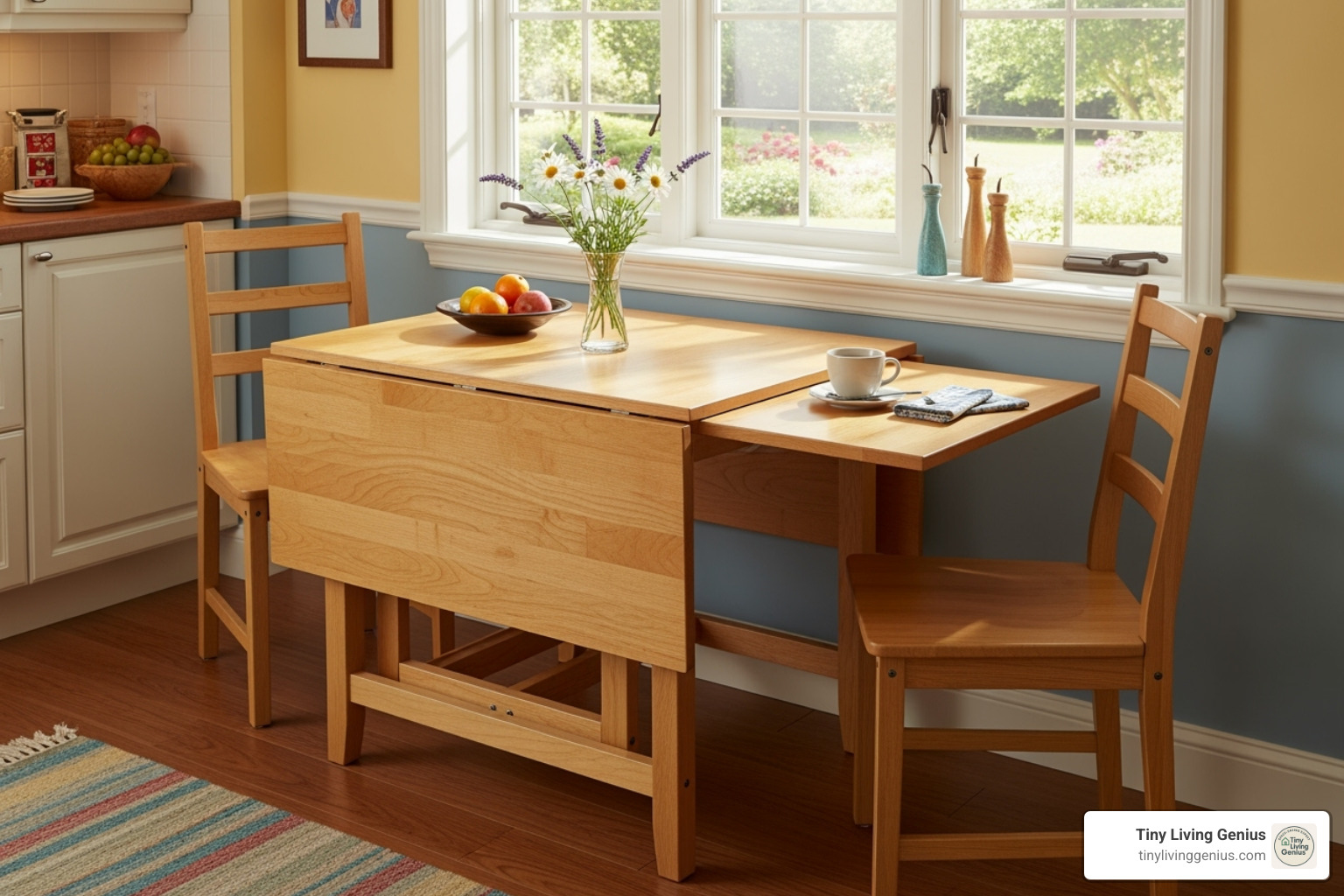
From extendable and drop-leaf tables that adapt to your needs to pedestal tables that free up legroom, there are many smart options. You’ll also find tables with built-in storage, folding tables, and bar-height tables that fit into the narrowest nooks. The key is matching the design to your specific needs.
Extendable & Drop-Leaf Tables: The Flexible Entertainer
For the ultimate flexibility in a small table dining room, consider an extendable or drop-leaf design. These tables act as two-in-one furniture: a compact table for daily use that transforms into a larger surface for entertaining. When collapsed, they maintain clear pathways and keep your space feeling open. When guests arrive, you simply pull out the hidden leaf or lift the hinged sides to add more seating. This adaptability means you can host a dinner party or game night without dedicating permanent space to a large table. Drop-leaf designs are especially versatile, as you can raise just one leaf to create a console or desk. For specific options, check out our guide on Fold Out Table designs, or explore a complete extendable dining set with matching chairs.
Pedestal Tables: More Legroom, Less Clutter
If you’re tired of banging your knees on table legs, a pedestal table is the solution. Instead of four corner legs, it features a single central support, which makes a huge difference in a small table dining room. The primary benefit is legroom; everyone can stretch out comfortably without navigating obstacles. This design also makes it easier to tuck in chairs or even squeeze in an extra person. Visually, a pedestal base looks less cluttered, helping your room feel more open and airy by reducing visual “stuff” at floor level. While common with round tops, pedestal bases can also support square or rectangular tables, offering design flexibility. For specific recommendations, take a look at our Pedestal Dining Table for 4 guide.
Tables with Built-in Storage: Functionality First
In small spaces, furniture that does double duty is essential. Dining tables with built-in storage are game-changers for a small table dining room, turning unused space beneath the tabletop into practical storage.
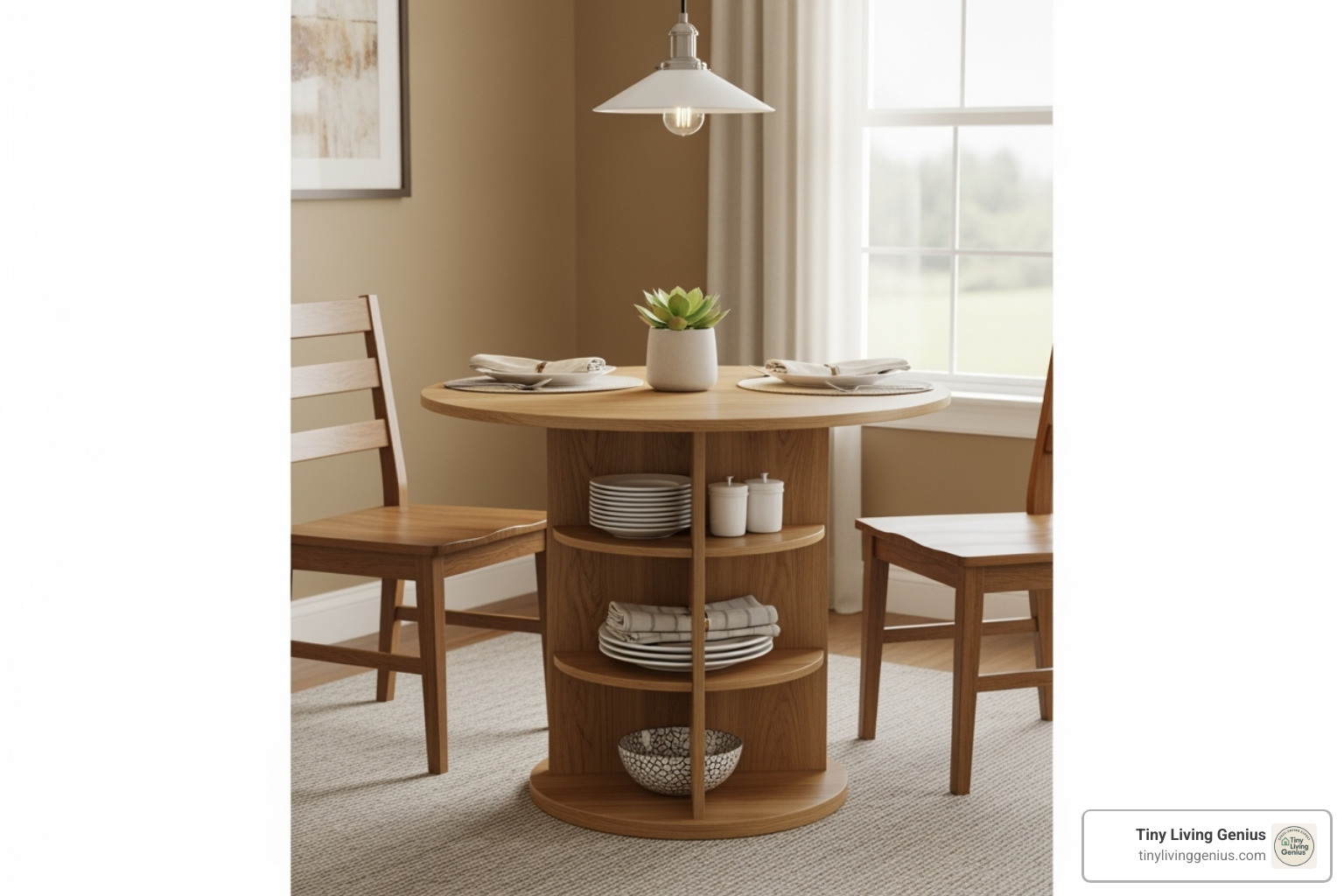
Storage can take the form of open shelves for placemats, drawers for utensils, or even small cabinets. This eliminates the need for a separate buffet or sideboard, which you may not have room for. By using vertical space effectively, these tables help keep your dining area organized and your tabletop clear. Everything you need is within arm’s reach, embodying the principles of smart, functional design. This approach is detailed in our guide on Creative Ideas for Small Space Furniture: Maximizing Functionality in Small Space.
Material & Visual Tricks for a Spacious Feel
How spacious your small table dining room feels is often more important than its actual size. That feeling comes down to the materials you choose and the visual tricks you employ. A heavy, dark oak table can feel overwhelming in a small nook, while a sleek glass-topped table with slim legs can make the same space feel open and airy. The right choices can genuinely transform your experience.
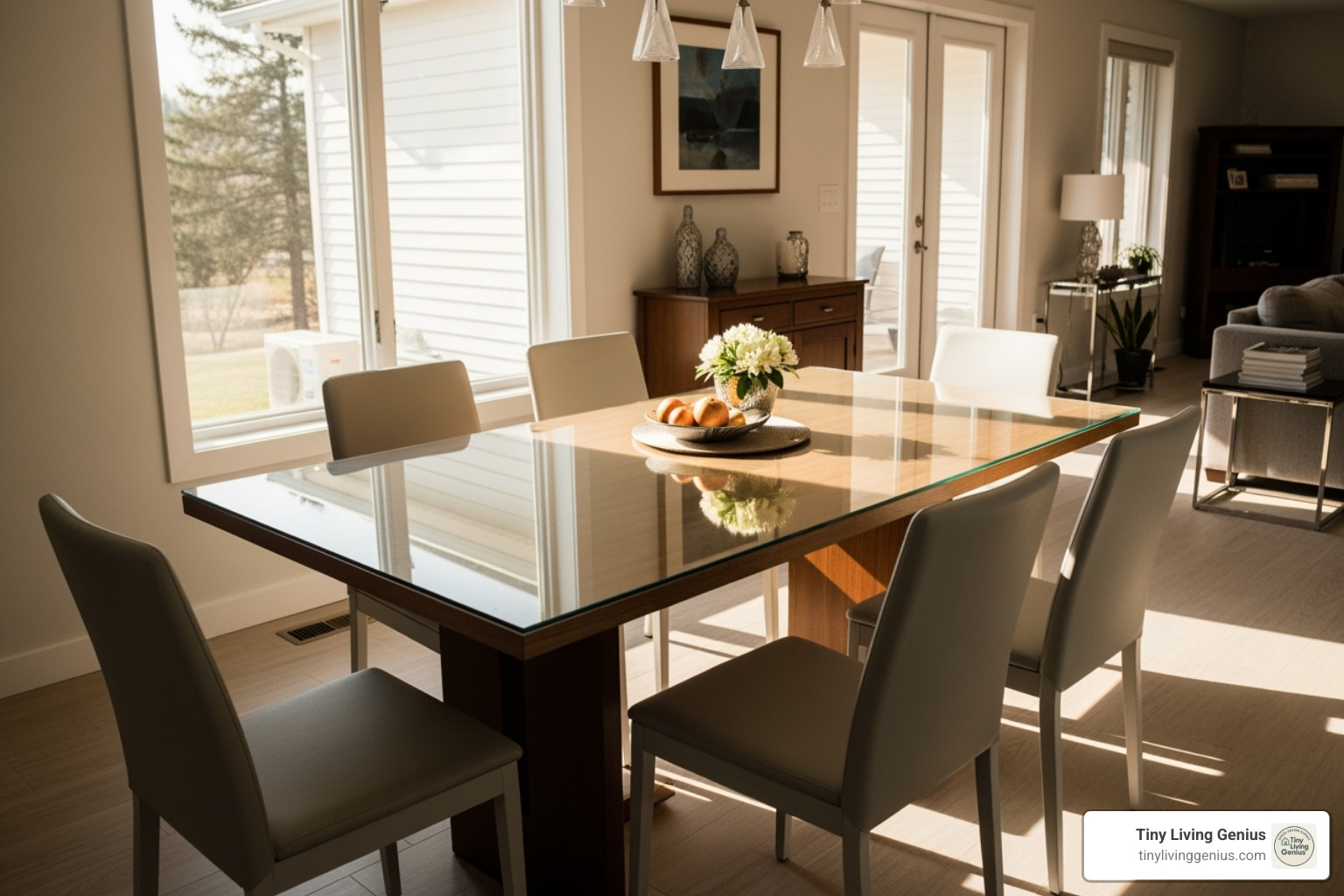
Common Materials for your small table dining room
Each material brings its own personality and practical considerations to your dining space.
-
Solid wood (like Oak, Maple, or Cherry) is a classic choice known for durability and warmth. It’s timeless and can be refinished, making it a long-term investment. However, it can be heavy and visually imposing, and is often the most expensive option.
-
Glass tops are excellent for creating an illusion of openness. By allowing you to see the floor beneath, glass makes a small table dining room appear larger and brighter. The downside is that it shows every fingerprint and can feel less cozy than wood.
-
Metal tables or bases bring an industrial or contemporary edge. They are sturdy and can be surprisingly lightweight. When paired with wood or glass, they create a balanced, mixed-material look. On their own, they can feel cold if not balanced with warmer textures in the room.
-
MDF (Medium-Density Fiberboard) is the budget-friendly champion. It’s lightweight and comes in many finishes, but it’s less durable than solid wood and cannot be refinished if damaged. It’s a great “for now” solution.
Design Considerations for a Small Table Dining Room
Beyond material, specific design details are your secret weapons for creating a spacious feel.
-
Lighter colors and finishes are essential. Light wood tones, white, or soft pastels reflect light, preventing the table from visually dominating the room and making the space feel more airy.
-
Visual lightness is key. Choose tables that reveal more of the floor. The more floor you can see, the larger the room appears. This is why glass tops and tables with slender legs work so well.
-
Slender, tapered legs make a huge difference compared to chunky supports. Thin profiles make the table appear to “float” rather than being heavily anchored to the floor.
-
Reflective surfaces, like high-gloss finishes or glass, bounce light around the room, contributing to an open feeling in a small table dining room.
-
Pedestal bases also contribute to a clean aesthetic by eliminating the visual clutter of four separate legs. For more ideas, explore Modern Furniture Designs: Maximizing Small Spaces.
Frequently Asked Questions about Small Dining Tables
When you’re standing in your apartment with a tape measure, specific questions often come up. Let me address the ones I hear most about creating a functional small table dining room.
What’s the difference between a table for 2 and a table for 4 in a small space?
This choice is about your lifestyle. A 2-person table (a bistro or breakfast nook set, typically 24-30 inches across) is perfect for individuals or couples in a very tight space. It’s specialized for cozy, simple meals. A 4-person table (36-48 inches for round, or ~30×48 inches for rectangular) offers much more versatility. While it takes up more room, it provides breathing space for spreading out with a laptop, hosting friends, or doing projects. The real difference is versatility versus specialization. A 4-seater is often worth the extra footprint because it adapts to the unpredictability of daily life. For more thoughts on flexible dining setups, take a look at Dining for every moment. Our guide on Dining Table for Small Place also walks through this decision.
How much clearance space do I need around my dining table?
The magic number is 3 feet (36 inches) of clearance between the edge of your table and any walls or other furniture. This buffer is crucial in a small table dining room. It allows people to pull out chairs and sit down comfortably, and lets others walk behind a seated person without squeezing past. It transforms a cramped obstacle course into a pleasant dining area. If 3 feet is impossible, a minimum of 24-30 inches can work, but it will feel tight. A pedestal base table can help in these situations by allowing chairs to tuck in more closely.
Can a small dining table also function as a desk?
Absolutely. A dining table that doubles as a workspace is the epitome of smart, multi-functional living. Rectangular tables are best for this, as their straight edges can sit flush against a wall to create a traditional desk setup. Ensure the table is sturdy and won’t wobble while you work. Also, consider if your dining chairs are comfortable for long periods. Extendable or drop-leaf tables are particularly great for this dual role; you can keep them compact as a desk and expand them for meals. The key is choosing a table that serves both purposes well. For creative ways to make this transition seamless, check out our guide on Table to Desk Ideas.
Conclusion: Dine in Style, No Matter Your Space
Finding the right furniture for a small table dining room is an opportunity to get creative. As we’ve seen, the right table can completely transform how you live in your space, whether it’s a round pedestal table to open up a room or a rectangular drop-leaf design that doubles as a desk.
Remember the key takeaways: shape matters for flow and function, materials influence the perception of space, and smart designs like extendable or storage tables add immense functionality. Always measure for clearance—at least 3 feet is ideal for comfortable use.
Your small table dining room should work for your life. The innovation in small-space furniture means you don’t have to compromise on style or function. Your perfect table is out there, ready to become the heart of your home.
At Tiny Living Genius, we believe living small means living smarter. For more inspiration beyond dining tables, Explore our complete guide to space-saving furniture, where we cover everything from clever storage to multi-functional pieces that make compact living feel spacious and intentional.

